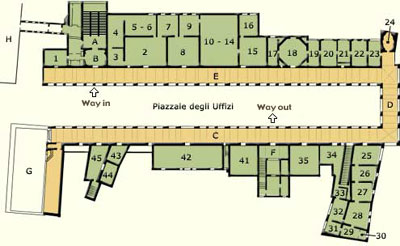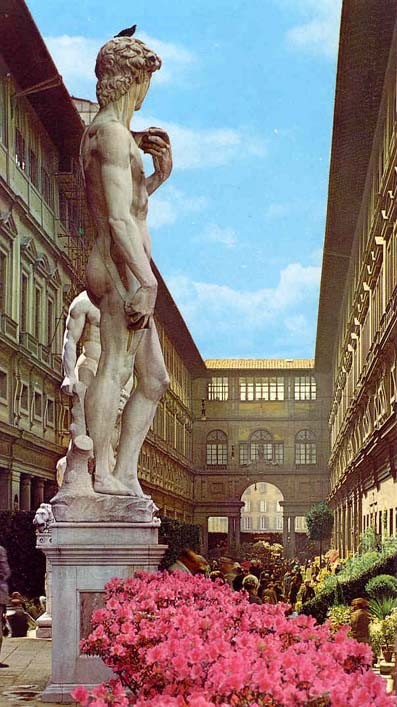
|
|

|
This was mostly a lecture day. At 9:00 we had a double lecture by Rocky Ruggiero. He covered the High Renaissance Art and then conducted a prep for tomorrow's visit to the Uffizi. It is evident from the floor plan chart below that the Uffizi -- number 2 on the map above, just above the Arno and east of the Ponte Vecchio -- contains an enormous amount of Renaissance art. We were told about the "Stendahl syndrome" and what to do about it: go to the rooftop bar and have a drink or coffee or just enjoy the fresh air. It turned out, about half way through our tour, to be very good advice.
Complete Catalogue: For a painting-by-painting catalog, go here, select a room, then a painting, then click "image".

|

|
 |
The Medici: History of Florence
At 3:00 Jane Zaloga began a double lecture on the History of Florence and the Medici. Jane Zaloga is a PhD student in the History and Theory of Architecture at Harvard University. The focus of her work is Italian Renaissance Architecture. She holds a Master of Arts in Italian Renaissance Art History from Syracuse university, and Bachelor of Architecture from the University of Notre Dame. Among her awards are: Fulbright Fellowship (1999-2000); Sinclair Kennedy Traveling Fellowship and Teaching Fellowships (Harvard University); Florence Fellowship (Syracuse University); Tau Sigma Delta (National Architecture Honor Society); Frank J. Montana Scholarship for Architectural Studies in Rome (University of Notre Dame); Beta Gamma Sigma (National Business Honor Society); Raymond P. Kent Award for Outstanding Achievement in Finance (University of Notre Dame); National Merit Award Scholarship; Notre Dame Scholar. Ms. Zaloga teaches during the academic year for Santa Reparata, and for Kent State University and Syracuse University in Florence.
No, that's not Jane. It's the picture she displays at the Contact Florence site.
|
"Republic"
The Rise of the City-State: Florence Before the Medici
The Medici Ascendant
The Golden Age
Expulsion of the Medici
|
Key Events:
1250 Guelph victory - foundation of the Primo Popolo 1293 Ordinances of Justic - Giano della Bella 1294 Site of new civic palace (Palazzo Signoria) chosen 1296 Cathedral of San Maria del Fiore begun 1342 Walter of Brienne - Duke of Athens - temporary tyrant 1348 Black Death 1378 Ciompi Revolt - short-lived enfranchisement of the working classes 1433 Cosimo il Venchio de'Medici sent into exile 1434 Cosimo returns - beginning of Medici power in Florence 1436 Consecration of the Cathedral of Santa Maria del Fiore 1478 Pazzi Conspiracy - attempt on life of Lorenzo 1492 Death of Lorenzo 1494 Medici run out of Florence 1498 Death of Fra Savonarola |
Interregnun and the Medici Rome
Dukes of Florence
Grandukes of Tuscany
The last Medici
|
Key Events:
1512 Medici return to power 1513 The Prince by Machiavelli 1527 Sack of Rome - Last Republic 1529 Siege of Florence 1530 Medici return - Alessandro de'Medici name Duke of Florence 1537 Alessandro assassinated 1555 Capture of Siena 1569 Cosimo I de'Medici named Grand Duke of Tuscany 1616 Galileo appears before the Inquisition 1731 Death of Gian Gastone, last of the Medici Granduchy of Florence passes to the Lorena, a branch of the Hapsburg Dynasty
| |||||||
Wine Tasting -- At 5:50 most of us left the lobby of the Hotel Reale for a 6:00 wine-tasting at the Wine Cafe' Di Sichi Massimilian, at Viale IV Novembre, 15/A. We had three wines - a white, a chianti and a blend of 5 reds. These were served with nice brushcetta-style tidbits to much on. Karen and I shared a table with Joyce and Dick.
When we returned to our Hotel dining room we found it jammed with tourists aus Duetschland, at least two busloads of them. Our calm was shattered. The staff handled everything masterfully. Another excellent dinner.
After dinner Sabrina gave us good, if painful, lecture on the flooding of Florence in 1966.


